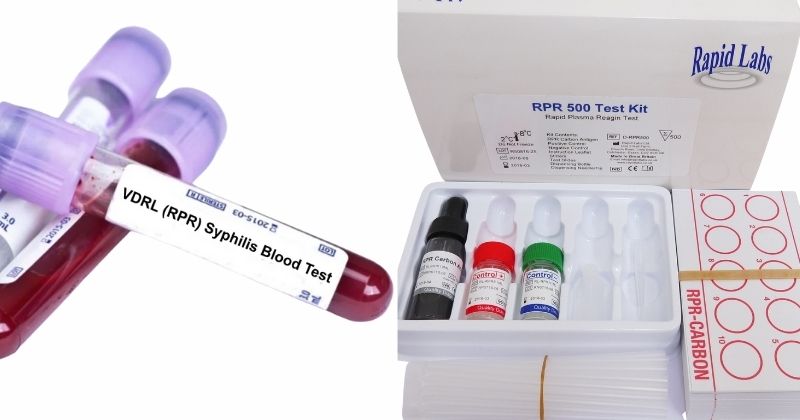The Venereal Disease Research Laboratory (VDRL) test is a widely used screening test for syphilis, a sexually transmitted infection (STI) caused by the bacterium Treponema pallidum. This test detects the presence of specific antibodies (reagin antibodies) produced in response to the infection, helping in early diagnosis and treatment.
Syphilis bacteria enter the body through mucous membranes, usually in the mouth or genitals, and can lead to serious health issues if left untreated. The VDRL test plays a crucial role in identifying this infection before complications arise.

Principle of the VDRL Test
The VDRL test is a non-treponemal serological test that detects reagin antibodies (IgG and IgM), which react with lipid antigens such as cardiolipin, cholesterol, and lecithin.
Scientists produce these antibodies not directly against the bacterium but against damaged host cell components and lipids released by the T. pallidum.
When a patient mixes their heat-inactivated serum with the antigen suspension, the presence of antibodies causes a flocculation reaction. This antigen-antibody complex forms clumps that can be seen under a microscope (typically 10x objective lens and 10x eyepiece).

Purpose of the VDRL Test
Your doctor may recommend a VDRL test if you show early symptoms of syphilis, such as:
- A painless sore (chancre).
- Swollen lymph nodes.
- A non-itchy skin rash.
Even in the absence of symptoms, the test is often ordered for:
- Pregnant women as part of routine prenatal care.
- High-risk individuals (e.g., those with HIV or other STIs).
- Follow-up testing after syphilis treatment (as recommended by the CDC).

What occurs throughout the VDRL Test?
In most cases, the only thing necessary for a VDRL is for a medical professional to draw the blood sample. A healthcare professional usually draws blood from a vein in the elbow or the back of the hand, and the technician then submits the sample to a lab for analysis to determine whether syphilis has caused the formation of antibodies. Before taking the VDRL test, there is no need to fast or stop taking any medications. Prior to the examination, the patient will be notified if the doctor wishes to waive this need. If the physician decides to make an exception, the patient will be notified of the procedure in advance.
Procedure of the VDRL Test
1. Blood Sample Collection
A healthcare professional inserts a sterile needle into a vein (usually in the arm or hand) and draws a blood sample into a collection tube. You do not need to fast or change your medication before the test unless your doctor advises otherwise.
2. Cerebrospinal Fluid (CSF) Collection (if required)
If syphilis has potentially affected the nervous system, a lumbar puncture (spinal tap) may be performed.
This involves:
- Lying on one’s side in a curled position.
- Cleaning and numbing the lower back.
- Inserting a spinal needle to collect a small CSF sample.
Interpretation of VDRL Test Results
Results are interpreted based on the appearance of clumping:
- Reactive: Large or medium clumps.
- Slightly reactive: Small clumps.
- Non-reactive: No clumping or very slight roughness.
The majority of patients with primary syphilis have positive VDRL tests, while those with secondary syphilis almost always have positive VDRL tests. Doctors can use it to evaluate how well syphilis treatment is working since the titer of reagin antibodies falls as treatment is successful.

Applications of the VDRL Test
- It is primarily used as the screening test for syphilis.
- Syphilis screening is a standard component of pregnancy testing.
- If you’re receiving treatment for another STI, such as gonorrhoea or HIV, or if you’re engaging in high-risk sexual behaviors, healthcare providers also administer the VDRL test for syphilis.
- The Center for Disease Control and Prevention (CDC) recommends that healthcare providers use VDRL for follow-up testing if they have already treated syphilis.
Uses of VDRL Test
- Due to the possibility of syphilis transmission from mother to child during pregnancy, healthcare providers frequently use the VDRL as part of a comprehensive sexual orientation screening program for sexually active people and recommend it for use in expectant mothers.
- Furthermore, healthcare providers use the VDRL test to identify people who exhibit syphilis-related symptoms, such as rashes or sores.
- This test screens for syphilis by looking for antibodies or proteins that the body produces in the presence of bacteria that cause the disease.
- If the test is positive, additional testing is necessary to confirm the diagnosis and to decide the best course of action.
Benefits of the VDRL Test
- This test is the most common quick and easy method for detecting syphilis.
- This tests are quick, simple to carry out and great for sample screening.
- The VDRL test can also aid in the diagnosis of syphilis that is present at birth. Because researchers cannot grow the syphilis-causing organism Treponema pallidum in artificial media, they find serological testing such as VDRL essential for screening for the disease.
- The patient’s symptoms of syphilis are not necessary for this test to be reliable.
- It has the ability to identify syphilis in asymptomatic individuals.
- It’s a non-treponemal test (nonspecific test) used to look for syphilis as well as other treponematose diseases like Yaws and Pinta.
Limitations of the VDRL Test
- Not specific to pallidum – false positives may occur in conditions like lupus, malaria, or pregnancy.
- Requires confirmatory tests for definitive diagnosis.
- May yield false negatives in early primary or late-stage syphilis.
Conclusion
The VDRL test remains one of the most widely used screening tools for syphilis. It is fast, reliable, and ideal for population-level screening or individual diagnostic purposes. As a non-treponemal test, it’s invaluable in both detecting active syphilis and monitoring treatment response.
